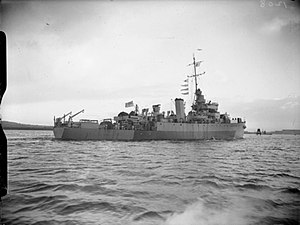HMS Cheerful (J388)
 HMS Cheerful
| |
| History | |
|---|---|
| Name | Cheerful |
| Namesake | Cheerful |
| Ordered | 30 April 1942 |
| Builder | Harland & Wolff, Belfast |
| Laid down | 20 August 1943 |
| Launched | 22 May 1944 |
| Commissioned | 13 October 1944 |
| Decommissioned | October 1947 |
| Recommissioned | 1951 |
| Decommissioned | 1954 |
| Identification | Pennant number: J388 |
| Fate | Scrapped, 1963 |
| General characteristics | |
| Class and type | Algerine-class minesweeper |
| Displacement |
|
| Length | 225 ft (69 m) o/a |
| Beam | 35 ft 6 in (10.82 m) |
| Draught | 12.25 ft 6 in (3.89 m) |
| Installed power |
|
| Propulsion |
|
| Speed | 16.5 knots (30.6 km/h; 19.0 mph) |
| Range | 5,000 nmi (9,300 km; 5,800 mi) at 10 knots (19 km/h; 12 mph) |
| Complement | 85 |
| Armament | |
HMS Cheerful (J388) was a turbine engine-powered Algerine-class minesweeper during the Second World War.
Design and description
The reciprocating group displaced 1,010–1,030 long tons (1,030–1,050 t) at standard load and 1,305–1,325 long tons (1,326–1,346 t) at deep load The ships measured 225 feet (68.6 m) long overall with a beam of 35 feet 6 inches (10.8 m). They had a draught of 12 feet 3 inches (3.7 m). The ships' complement consisted of 85 officers and ratings.[1]
The reciprocating ships had two vertical triple-expansion steam engines, each driving one shaft, using steam provided by two Admiralty three-drum boilers. The engines produced a total of 2,400 indicated horsepower (1,800 kW) and gave a maximum speed of 16.5 knots (30.6 km/h; 19.0 mph). They carried a maximum of 660 long tons (671 t) of fuel oil that gave them a range of 5,000 nautical miles (9,300 km; 5,800 mi) at 10 knots (19 km/h; 12 mph).[1]
The Algerine class was armed with a QF 4 in (102 mm) Mk V anti-aircraft gun[2] and four twin-gun mounts for Oerlikon 20 mm cannon. The latter guns were in short supply when the first ships were being completed and they often got a proportion of single mounts. By 1944, single-barrel Bofors 40 mm mounts began replacing the twin 20 mm mounts on a one for one basis. All of the ships were fitted for four throwers and two rails for depth charges.[1]
Construction and career
The ship was ordered on 30 August 1941 at the Harland & Wolff at Belfast, Ireland. She was laid down on 20 August 1943 and launched on 22 May 1944. The ship was commissioned on 13 October 1944.[3]
In April 1945, she took part in the minesweeping operations together with 18th and 10th Minesweeping Flotilla to the passage to Cuxhaven and Hamburg, also known as Operation Dropkick.
In October 1947, she was decommissioned and put into the reserve fleet.
In 1951, she was recommissioned and put into the Fisheries Protection Flotilla. In June 1953, she took part in the Coronation Review at Spithead. She was out of service again in 1954.
In 1966, she was sold to BISCO for scrap by the Lacmots at Queenborough, Kent in which she arrived in September of the same year.
References
Bibliography
- Chesneau, Roger, ed. (1980). Conway's All the World's Fighting Ships 1922–1946. Greenwich, UK: Conway Maritime Press. ISBN 0-85177-146-7.
- Colledge, J. J.; Warlow, Ben (2006) [1969]. Ships of the Royal Navy: The Complete Record of all Fighting Ships of the Royal Navy (Rev. ed.). London: Chatham Publishing. ISBN 978-1-86176-281-8.
- Peter Elliott (1977) Allied Escort Ships of World War II. MacDonald & Janes, ISBN 0 356 08401 9
- Lenton, H. T. (1998). British & Empire Warships of the Second World War. Annapolis, Maryland: Naval Institute Press. ISBN 1-55750-048-7.